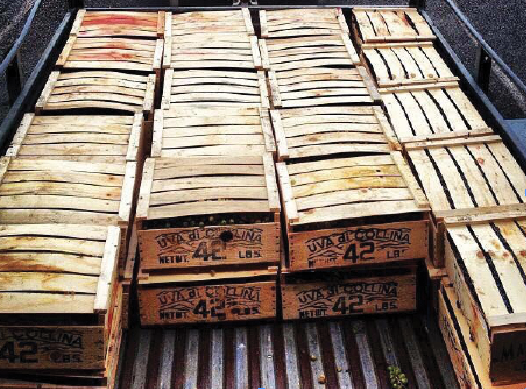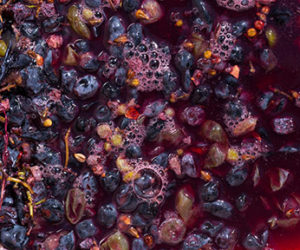 If you’re like me, you may receive emails from one or more fresh-grape vendors offering winegrapes for sale in season. The emails usually indicate what grape varietals will be available or are currently on sale. You can check WineMaker’s supplier directory for possible fresh-grape vendors in your area. You’ll also notice that fresh grapes will be priced and sold by the lug. A lug is the common name given to a standardized cardboard, wood, or plastic crate that the grapes would be packed in by the grower. Each lug of winegrapes should contain between 33-36 lbs. (15-16 kg) in total, but that number can vary depending on vendor and source region of the winegrape. Committing yourself to purchasing that first lug can be intimidating. But a lot of that can be mental, and as the old idiom goes, where there is a will, there’s a way.
If you’re like me, you may receive emails from one or more fresh-grape vendors offering winegrapes for sale in season. The emails usually indicate what grape varietals will be available or are currently on sale. You can check WineMaker’s supplier directory for possible fresh-grape vendors in your area. You’ll also notice that fresh grapes will be priced and sold by the lug. A lug is the common name given to a standardized cardboard, wood, or plastic crate that the grapes would be packed in by the grower. Each lug of winegrapes should contain between 33-36 lbs. (15-16 kg) in total, but that number can vary depending on vendor and source region of the winegrape. Committing yourself to purchasing that first lug can be intimidating. But a lot of that can be mental, and as the old idiom goes, where there is a will, there’s a way.
Finding the Will
The first step is to figure out just how many lugs you wish to purchase. For the first time fresh-grape winemaker, a good rule of thumb is that 110 lbs. (50 kg) or 3 standard-sized lugs at 36 lbs. (16 kg), will produce roughly 6 gallons (23 L) of wine — akin to most standard wine kits. You can scale up or down from there depending on your winemaking capacity and ambitions (try to stay modest though).
Choosing your first varietal to crush and ferment can be troublesome because many grape vendors these days have an amazing array of grapes available. My advice would be to keep it simple, go with a single grape variety that is a forgiving variety, in other words that can survive the basic hiccups involved with rough handling or missing an acid addition. You can talk to your vendor about what variety that may be but a Vinifera like Merlot and Chardonnay may be good jumping off points.
Most Vinifera varietals should arrive at roughly 22-25 °Brix (roughly 11-13% potential alcohol by volume). You could bring a refractometer along to test the grapes if you have one, giving a few spot checks of different grapes in different clusters. Be sure to inspect the grapes making sure that they look healthy, relatively insect-free, and that there isn’t a lot of vineyard waste in the lug.
Making Your Way
In the “Beginner’s Block” found in the June-July 2018 issue, we talked about the equipment necessary to get a prospective first time fresh-grape winemaker going. Many of the bigger ticket items that might hold folks back can often be found available for customer’s use at the site where you purchase the lug(s) of grapes. Alternatively the equipment can sometimes be borrowed, rented, or purchased, depending on your budget.
The first two steps are key . . . the crush and the press. There are many ways to crush a grape and I will refer you to the “Techniques” column “Crushing Grapes” found here for much more on this subject. Pressing the grapes is most often done with a specialized tool and crafting your own grape press is one option if you are a relatively handy person or trying to keep the hobby on budget. You could also press the grapes by hand with some patience, muscle, and a large strainer bag. These bags are often called fermenting bags, but you could also look to the homebrewing world to find their Brew-In-A-Bag for a highly durable version.
Keeping your equipment clean and sanitized whenever possible as well as keeping up on your sulfite additions is key to crafting clean wine. For sulfite calculations, please visit our website to find one you can use for free at https://winemakermag.com/sulfitecalculator.
While there is a lot of equipment that advanced or more experienced home winemakers may have on hand at their house, first time fresh-grape winemakers must remember that grapes will naturally turn into wine. All you need to do is give them a little guidance. Try to keep it simple, and most importantly, try to make it fun. If you are ready to give fresh-grape winemaking a try, don’t be discouraged by one or two hurdles. Our ancestors have been making wine from grapes for millennia, because they had the will and found a way.







